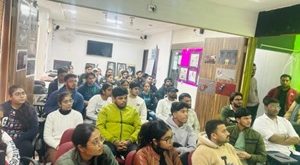A bloated stomach can be caused by a host of issues like flatulence, indigestion and even Irritable Bowel Syndrome (IBS); however, not all bloats are temporary. Sometimes a bloated stomach might be because of a more grievous underlying cause, like a tumor. A tumor is an abnormal mass or growth of tissues that can happen in any organ. There will be other symptoms too, which will manifest over time, and they need to be taken seriously. Consult a doctor right away if you observe any of the following signs:
- Bloating or pressure in the lower abdomen
- Frequent urination
- Nausea or vomiting
- Sudden and severe pain in the lower abdomen
In a similar case, a 64-year-old woman, with a history of lifestyle comorbidities like Hyperthyroidism, Hypertension, and Ischemic Heart Disease, came to us complaining of pain in her lower abdomen, gradual abdominal enlargement and frequent urination for four consecutive months. On undergoing an Ultrasonography and Magnetic Resonance Imaging (MRI), a complex Cystic Lesion (tumor) measuring 34 x 20 x 29cm, with multiple internal septations (internal walls within the tumor), was found. The tumor weighed a whopping 12 kilograms, and the 60yr old patient did not have any inkling!
To make matters complicated, the tumor was attached to other organs and was compressing the ureters (the pipe that carries urine from the bladder to the Kidney), obstructing normal flow of urine. This obstruction was causing the ureter closest to the Kidneys to swell up. It was also causing Hydronephrosis, i.e. swelling up of the Kidney due to urine retention, and exerting pressure on the major blood vessels, that go to the intestines, Kidneys, and urinary bladder. Hence it was decided by a multi-disciplinary team consisting of Anesthesiologist, Oncologist, Psychologist, Nutritionist, and a Surgical Oncologist that the tumor would be removed via Laparotomy (a surgical incision into the abdomen).
A Laparotomy is the process of opening the abdomen with an incision or ‘cut’. The decision was based on a radiological (CT scan) findings since the tumor had probability of malignancy. The surgery was successful, and a precise dissection of the mass was done, which is a big feat considering the complexity of the tumor and its proximity to vital organs. Post-surgery, the patient was kept in the ICU, and her pulse rate, blood pressure, urine output, changes in abdominal girth, breathing pattern etc. were continuously monitored closely for 24 hours, after which she was shifted to the ward.
The possibility of malignancy and presence of multiple co-morbidities made this case really complex, and, in such cases, a multidisciplinary team is a must. The team works in tandem with the surgeon for the best possible patient outcome. Early diagnosis is just as important so one should be mindful of the signs and symptoms.
~ Authored by Dr Anil Heroor, HOD & Senior Consultant-Surgical Oncology, Fortis Hospital, Mulund ~
 Newspatrolling.com News cum Content Syndication Portal Online
Newspatrolling.com News cum Content Syndication Portal Online






